The biceps get too much credit. Don’t get us wrong; training your biceps is a must for bigger and stronger arms. But your triceps make up two-thirds of your upper arm mass and cover the entirety of the back of your arm. That’s a chunk of prime real estate.
With that in mind, here are 11 of the best triceps exercises and provide knowledge on how to train the muscle to help you improve your bench press strength and build a meatier pair of arms.
11 Best Triceps Exercises
- Close-Grip Bench Press
- Dip
- Triceps Pushdown
- Skull Crusher
- Floor Press
- Overhead Triceps Extension
- Standing Landmine Press
- Diamond Push-Up
- Push Press
- Cross-Body Cable Extension
- Cable Kickback
Recent Updates: This article was originally written by Mike Dewar, a veteran BarBend contributor and coach. Dewar has a number of certifications as well as a Masters degree in Exercise Physiology. On Mar. 26, 2024, BarBend Senior Writer Jake Dickson updated the exercise selections in this article to better reflect BarBend’s evolving standards for training content. You can read more about that process here!
Editor’s Note: The content on BarBend is meant to be informative in nature, but it should not be taken as medical advice. When starting a new training regimen and/or diet, it is always a good idea to consult with a trusted medical professional. We are not a medical resource. The opinions and articles on this site are not intended for use as diagnosis, prevention, and/or treatment of health problems. They are not substitutes for consulting a qualified medical professional.
1. Close-Grip Bench Press
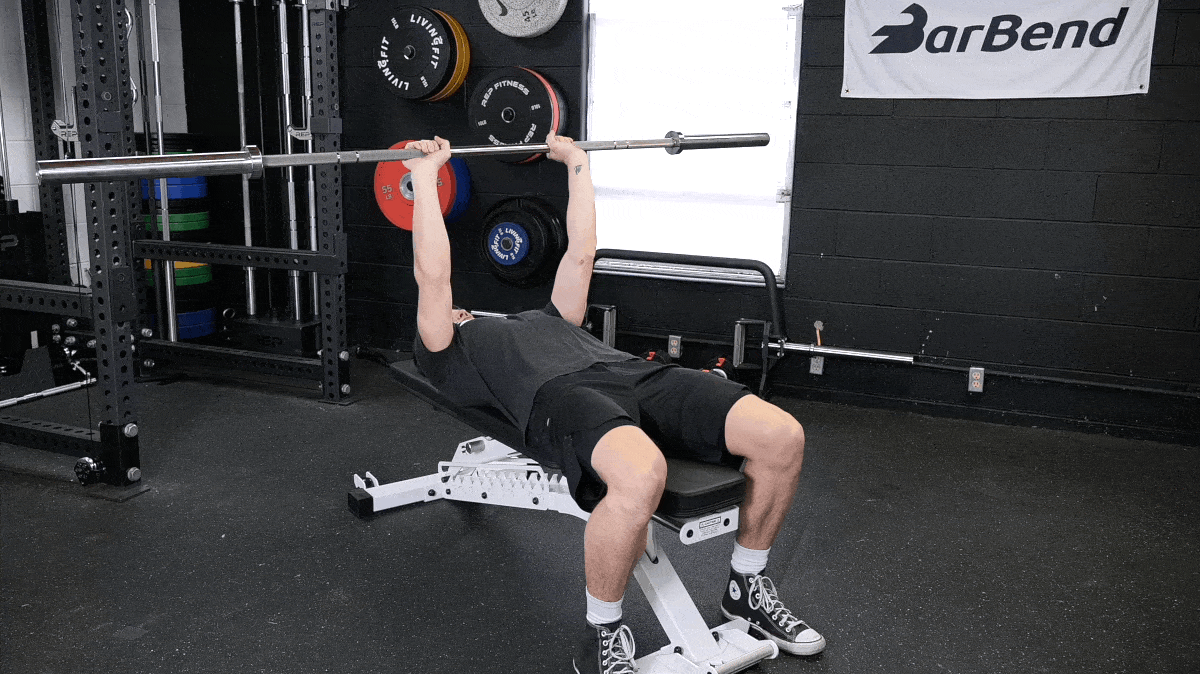
| Equipment Needed | Bench press station, barbell, weight plates, wrist wraps (optional) |
| Muscles Worked | Chest, triceps, shoulders |
| Sets & Reps | 3 x 6-8 |
This compound triceps exercise has you lift a bar with your hands set shoulder-width apart. This bench press variation shifts the load more to your triceps. You won’t be able to lift as much weight with the close-grip bench press, but you’ll strengthen your triceps.
The arms-in form you need to target your triceps will take the onus off of your shoulder joint. More muscle mass on the back of your arms will directly carry over to the lockout, or top portion, of your standard bench press.
How To Do It
- Set yourself up similar to a flat bench press, with your hands set inside shoulder-width and your elbows tucked into the body.
- Pull the bar out of the rack and stabilize it over your chest.
- Pull the elbows inwards as the bar descends to the chest.
- Once you have touched the chest, press through the palms, feel the triceps engage, and lift the weight back up.
Modifications
- Make It Easier: If you prefer dumbbell triceps exercises, this move can be performed with dumbbells as well.
- Make It Harder: Try pausing at the bottom of each rep with the bar on your chest.
2. Dip
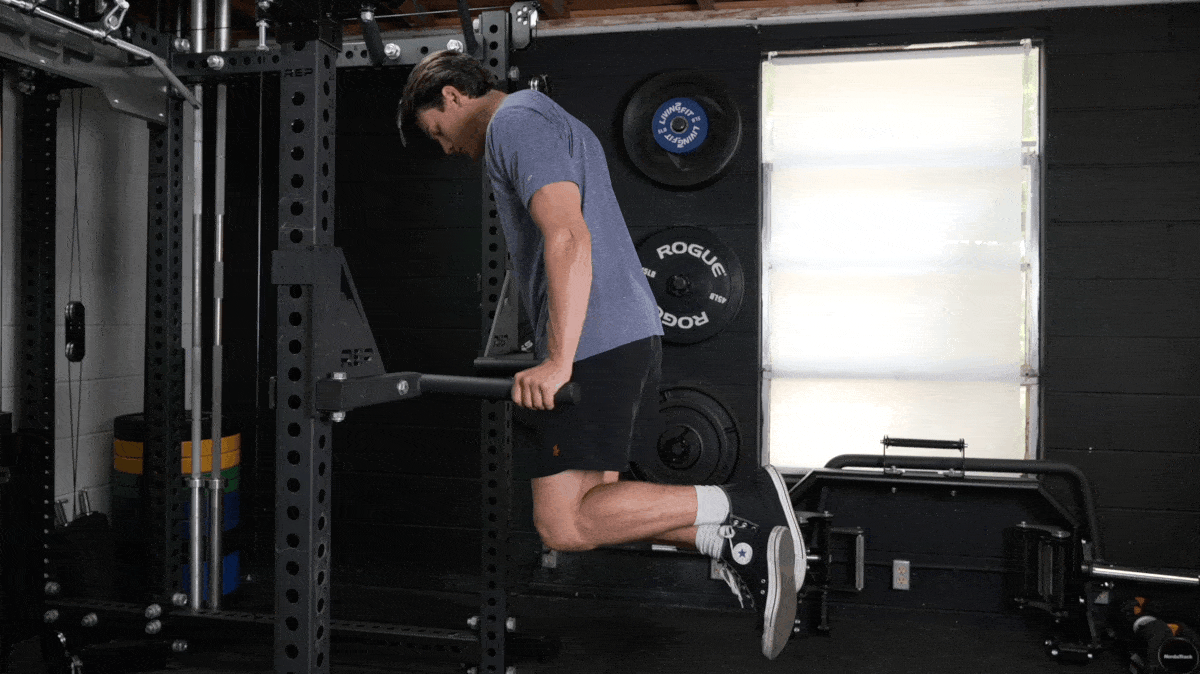
| Equipment Needed | Dip station, plyo box or chair, wrist wraps (optional), dip belt (optional) |
| Muscles Worked | Triceps, chest, shoulders, core |
| Sets & Reps | 2 – 3 x 10+ |
Performing regular dips on a set of parallel bars instead of angled bars or rings will recruit your triceps more as arms will be tucked in, not flared out. Your shoulders should feel better, too, since they’re in a more neutral position throughout the exercise.
You’ll also be more stable as the bars are closer together than angled dipping bars or rings. Lastly, we like dips since they can be done effectively with just your body weight.
How To Do It
- Grab the parallel bars with your torso upright (with a slight lean forward) as you are suspended.
- Have your elbows almost fully extended to support this position.
- With the chest up and shoulder blades squeezed together, bend at the elbows as you lower yourself downward until the elbows reach 90 degrees.
- Press yourself upwards until you fully extend the elbows and repeat.
Modifications
- Make It Easier: The bench dip or chair dip are great options to help you progress toward doing full bodyweight dips.
- Make It Harder: Add weight by wearing a dip belt or holding a small dumbbell between your ankles.
3. Triceps Pushdown
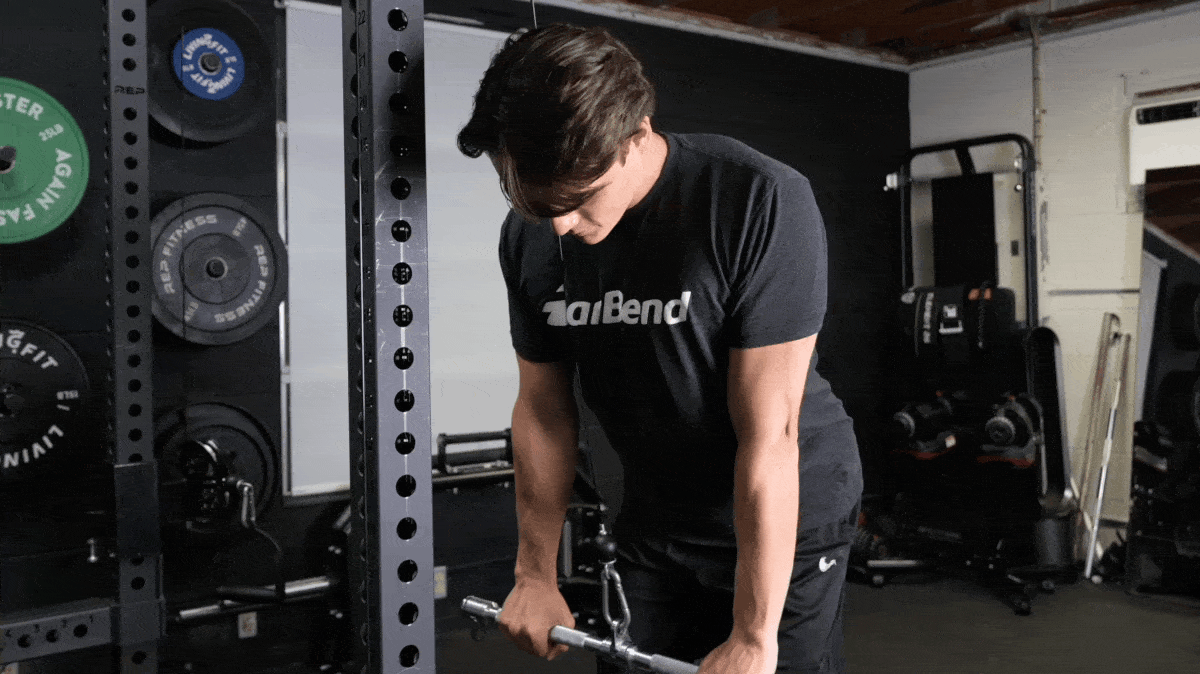
[Read More: The Best Cable Machines for Small Spaces, Bodybuilders, and More]
| Equipment Needed | Adjustable cable station, attachment of choice |
| Muscles Worked | Triceps |
| Sets & Reps | 2 – 4 x 8 – 12 |
You can really isolate your triceps with the triceps pushdown. To perform the pushdown, you either grab a resistance band or a cable pulley, step back, so the band or cable is taut, and then push it downward by flexing your triceps. Since just your triceps are moving the weight, you can better hone in on them.
We think the pushdown is one of the best tricep exercises for mass because it completely isolates the muscle, which leads to great pumps and plenty of hypertrophy.
How To Do It
- Set the cables or band at a high anchor point. With your body facing the band, place your feet together and elbows to your sides (by your ribs).
- The chest should be up, and the back flat, with the hips angled slightly forward.
- Grab the handles or band and fully extend the elbows to push the handles or band down, making sure to keep the elbows slightly in front of the shoulders.
Modifications
- Make It Easier: Play around with different cable attachments until you find the one that is most comfortable for you.
- Make It Harder: Try a drop set at the end of your pushdown workout.
4. Skull Crusher
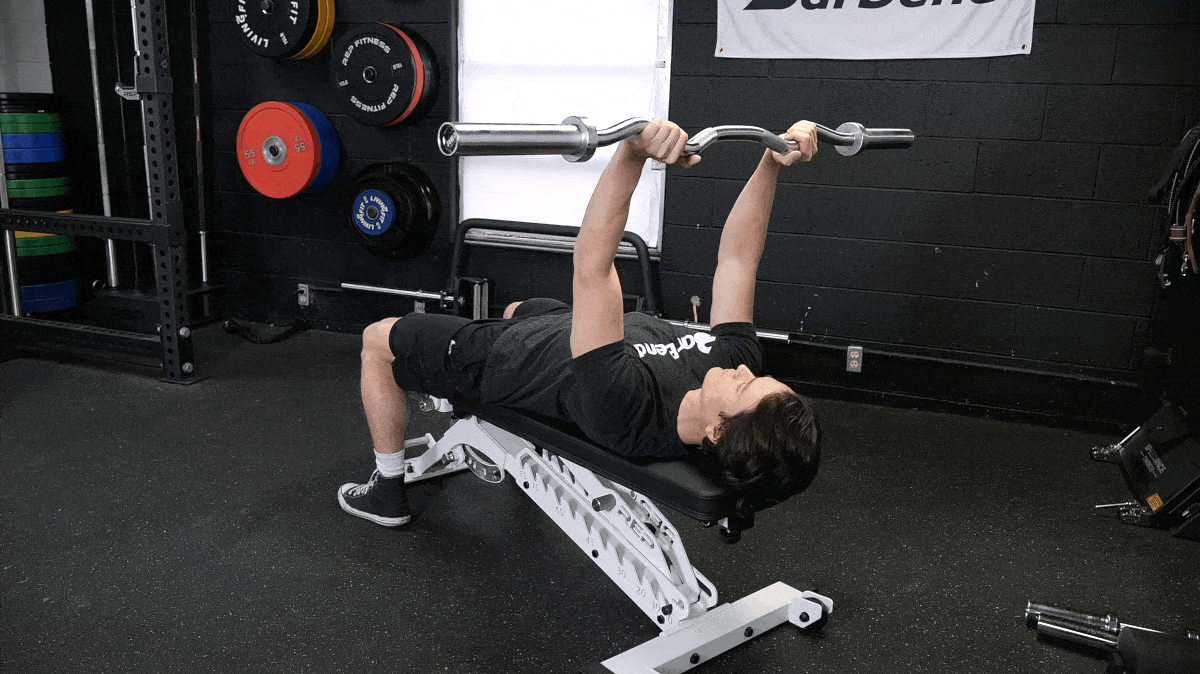
| Equipment Needed | Straight or cambered barbell, weight plates (optional), flat bench |
| Muscles Worked | Triceps |
| Sets & Reps | 2 – 3 x 10 – 12 |
This triceps exercise variation has you lower a barbell (or dumbbells or cable pulley or kettlebells) to your forehead to stretch the triceps muscle.
You’ll be able to isolate the triceps with the skull crusher, but in a position that also allows you to move heavier weight than you could with a pushdown. As a result, the skull crusher is a great free weight triceps exercise.
How To Do It
- Start by lying back down on a bench, with the hands supporting a weight (a barbell, dumbbells, or various cable attachments) at the top of the bench pressing position. The back and hips should be set up identical to a bench press.
- Pull the elbows back slightly so that they are pointing behind you (rather than directly vertical) as you bend the elbow joint, lowering the bar handle or loads towards your head.
- The bar should nearly make contact with the forehead. Feel the stretch on the triceps and partially on the lats. Push the bar back up.
Modifications
- Make It Easier: Do this move on the floor or work with dumbbells instead of a barbell.
- Make It Harder: Lie on an adjustable bench with the backrest set at a low (10 to 20-degree) incline.
5. Floor Press
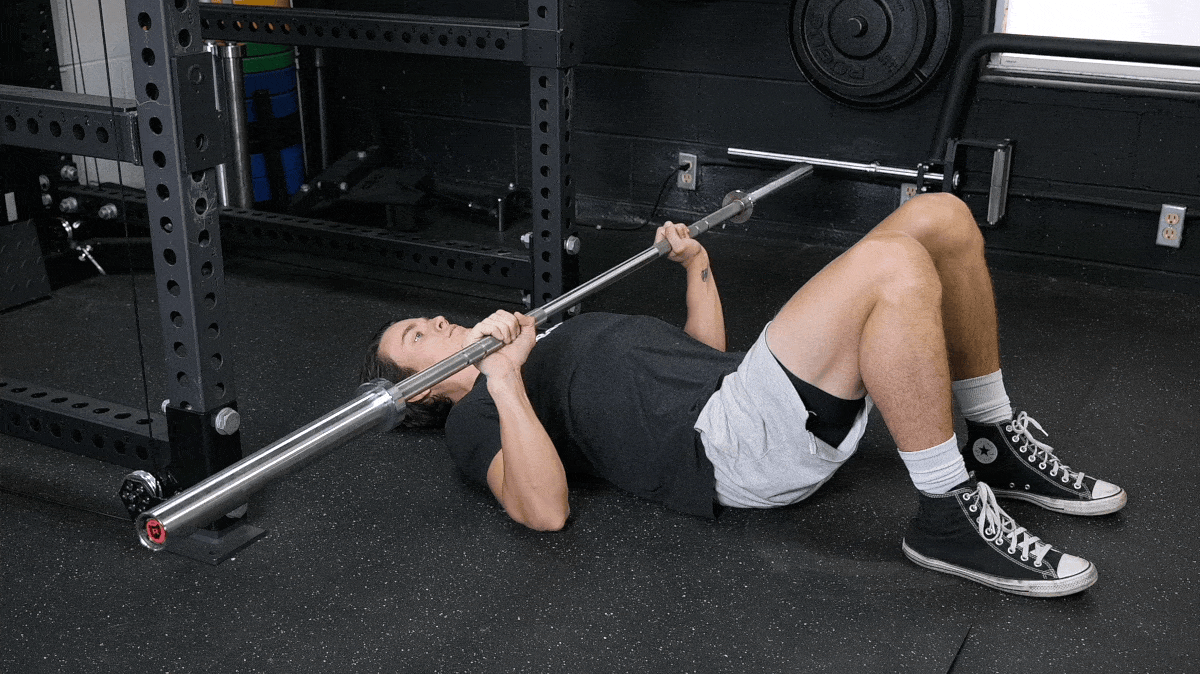
[Read More: The Best Home Gym Flooring and Expert Buying Guide]
| Equipment Needed | Barbell, weight plates, squat rack (optional) |
| Muscles Worked | Triceps, shoulders, chest |
| Sets & Reps | 2 – 3 x 10 – 12 |
This is a popular bench press variation among powerlifters who need to strengthen the top portion of the lift. By pressing a barbell from the floor, you’re limiting your arms’ range of motion.
This means you can typically press more weight, which equates to a stronger bench press and stronger triceps. The floor press is also a suitable work around if you can’t bench with a full range of motion due to an injury or, even, because all the benches are taken in a busy gym.
How To Do It
- Lay down in front of a power rack and extend your arms. Take note of where they end and adjust the hooks so that the barbell sits where your hands reach.
- Get back under the now-loaded barbell and plant your feet firmly on the floor.
- Grab the bar with your typical types of bench press grip. Lift the bar out of the rack, and lower the barbell to your sternum. Keep your elbows tucked in at 45 degrees. Press back up.
6. Overhead Triceps Extension

| Equipment Needed | Adjustable cable station, attachment of choice |
| Muscles Worked | Triceps |
| Sets & Reps | 1 – 2 x 12 – 15 |
Triceps extensions are performed with a variety of tools and in a variety of postures. When performing overhead triceps extensions with a resistance band, the extra stretch on the band provides ample tension from the get-go and only gets harder as you extend the elbows.
This movement is great for both muscular hypertrophy and lockout strength. It’s also one of the only long head triceps exercises out there. If you prefer cable triceps exercises, you can do this one with a cable instead.
How To Do It
- With the band underneath the middle of both feet, step forward with one foot and bring the handles of the band up behind your ears.
- Standing tall and keeping your elbows tucked in, extend the elbows until lockout, and pause for a second.
- Slowly lower down to the starting position and then repeat.
Modifications
- Make It Easier: Try this move one arm at a time if you have inflexible shoulders. You can also do it seated if necessary.
- Make It Harder: Try one-and-a-half reps to emphasize the stretched position.
7. Standing Landmine Press
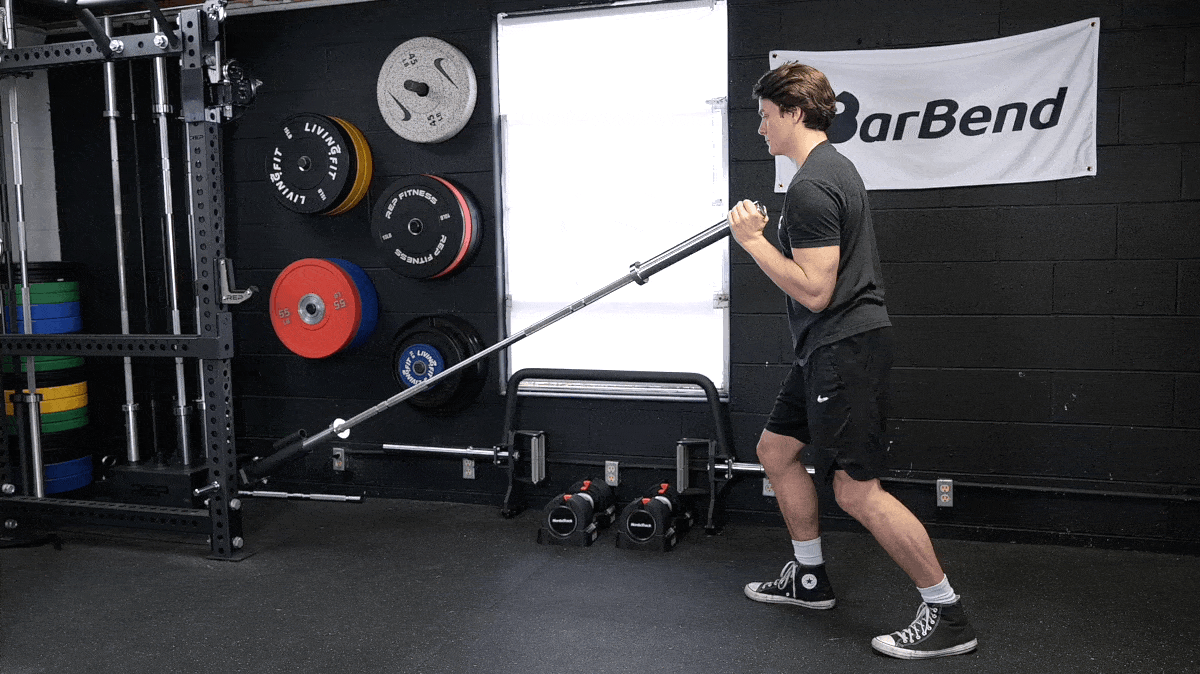
| Equipment Needed | Landmine attachment, barbell, weight plates (optional) |
| Muscles Worked | Triceps, shoulders |
| Sets & Reps | 2 – 3 x 10 – 12 |
If you can’t train your triceps pain-free, the standing landmine press can come in clutch. The nature of the implement used increases scapular stability and control.
The grip and upper arm position will also likely allow you to train around elbow or shoulder discomfort and still get a good session in.
How To Do It
- Stand with your feet hip-width apart and hold the end of the barbell just in front of your shoulder. Brace your core and lats and grip the barbell tight.
- Then, press to lockout by extending the elbow and reaching forward at the end of the movement. Slowly lower back down and repeat.
8. Diamond Push-Up
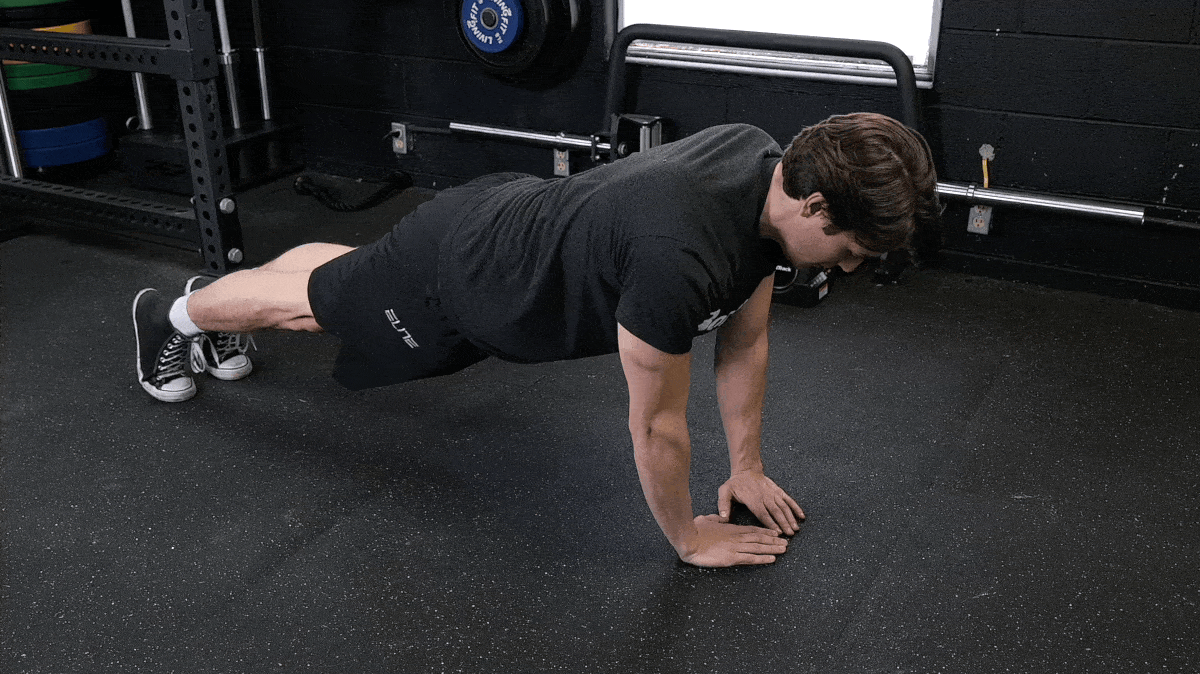
| Equipment Needed | Exercise mat (optional) |
| Muscles Worked | Triceps, chest, shoulders |
| Sets & Reps | 3 x 15 |
Like the close-grip bench press, the hand placement of the diamond push-up shifts more of the emphasis on the triceps. Due to the narrower base of support, you’ll get increased core stability while training the chest, shoulders, and triceps.
Because of this, you may not be able to do as many reps as in your usual push-up, but your triceps will love it. You can also utilize diamond push-ups as an at-home triceps exercise.
How To Do It
- Making a perfect diamond with your hands is not necessary, but the idea is to keep your hands close to focus on the triceps. Adjust your hand position to see what works for you.
- Perform a push-up with control while keeping your core and glutes tight to keep your spine neutral.
- Keep your elbows tucked alongside your ribcage, without flaring, during the entire movement.
Modifications
- Make It Easier: You can do this one on your knees or with your hands not quite touching to make it easier.
- Make It Harder: Try decline diamond push-ups by elevating your feet slightly.
9. Push Press
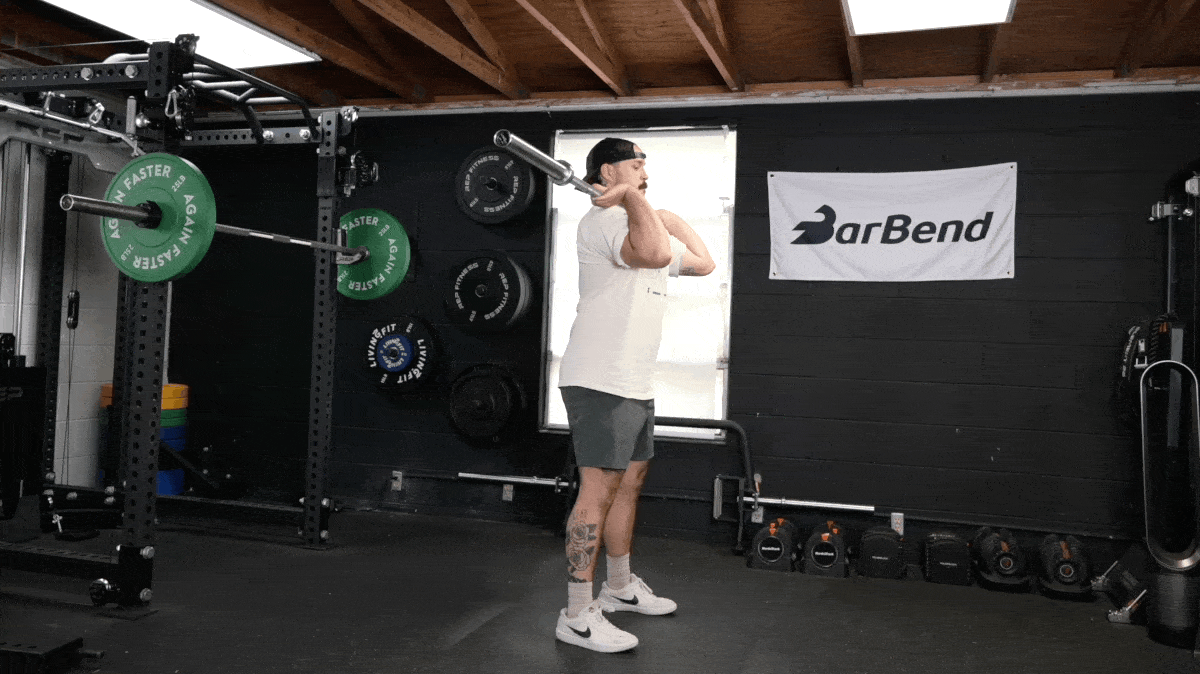
| Equipment Needed | Barbell, bumper plates, squat rack, wrist wraps (optional) |
| Muscles Worked | Triceps, upper back, shoulders, legs, core |
| Sets & Reps | 3 – 4 x 3 – 5 |
With enough weight on the barbell, just about any pressing movement can be considered a triceps exercise as well. Overhead pressing is fantastic for overall upper-body strength, but your performance may not be limited by your triceps specifically.
By using your leg drive to power through the first half of the lift — where your shoulders do the most work — the push press helps you apply tons of mechanical tension to your triceps. Sets of five reps have never felt so hard.
How To Do It
- Unrack a barbell from a squat rack and hold it in the front rack position with a loose grip and your feet planted under your hips or slightly wider.
- Dip into a half squat; sink down until your knees come in line with your toes, but not much deeper.
- Aggressively reverse the motion and push into the floor hard as if you were going to jump.
- Your entire lower body should extend, at which point tilt your head back and allow the bar to fly off your shoulders.
- As the bar passes your head, press with your arms to lock it out firmly overhead.
10. Cross-Body Cable Extension
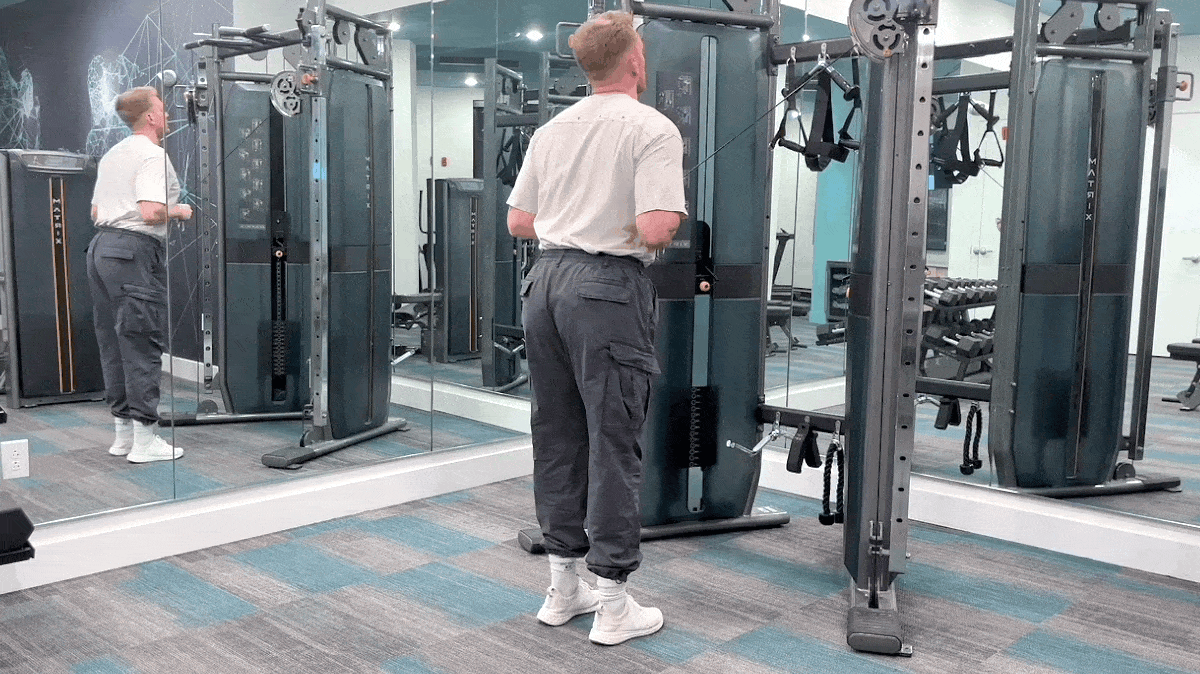
[Read More: The Ultimate 10-Week Powerbuilding Workout Routine for Mass and Strength]
| Equipment Needed | Adjustable cable station |
| Muscles Worked | Triceps |
| Sets & Reps | 2 – 3 x 12 – 15 |
When it comes to triceps training, cables are your best friend. While free weights are in no way inherently dangerous, plenty of folks find it easier and more comfortable on the elbows to perform high-intensity training on the arm with exercises like the cable cross-body extension.
Bodybuilders in particular adore this movement for its hypertrophic potential; few exercises will allow you to apply so much stress to your triceps with such little weight. You also get the benefits of working each triceps separately during a simultaneous double-armed set. This saves time while not allowing one arm to pick up the slack of the other.
How To Do It
- Stand between two cable trees with each shoulder-height attachment in your opposite hand; your right hand should hold the left attachment, and vice versa.
- Take a step or two backward to pull the plate stack up and apply some tension to the cable. Your forearms should be crossed in front of your body forming an “X” shape.
- From here, extend your elbows while keeping your upper arms tucked to your sides or slightly behind your body.
11. Cable Kickback

| Equipment Needed | Adjustable cable station |
| Muscles Worked | Triceps |
| Sets & Reps | 2 x 15 |
As dumbbell triceps workouts go, the kickback is less than ideal. Its biggest hindrance is the inconsistent resistance curve; your reps are very easy at the beginning and too difficult at the end.
Working with cables instead of a dumbbell resolves this issue and transforms an otherwise mediocre movement into a killer triceps exercise. Use this one to cap off your next arm workout and see for yourself.
How To Do It
- Set a cable fixture at around waist height and grab the attachment in your palm. Use your non-working arm to brace yourself against the cable tree itself.
- Tip over so your torso is roughly parallel to the floor and stagger your feet.
- Tuck your upper arm back and against your torso.
- Use your triceps to extend your elbow.
Modifications
- Make It Easier: If you can’t hinge over, do this move standing up with your elbow pushed back behind your torso slightly.
- Make It Harder: Try it with two cables at the same time.
4 Triceps Workouts To Try
Yes, your triceps will get plenty of action from your best chest exercises and shoulder exercises. But when you’re aiming to bust through some next level shirt sleeves, try the best triceps workouts out there to give your arms the boost they need.
[Related: Best Weight Benches]
Triceps Workout for Beginners
As a beginner, targeted arm training may not be necessary to reap some gains in the gym. That said, if you’re looking to add triceps mass specifically, remember as a beginner that it is important to prioritize frequency and mindful practice over lifting the heaviest weights possible. Strength training is a long road, so set yourself up for success by building good habits early.
Perform this workout with higher training frequency and less intensity (meaning weight on the bar) for at least three to four weeks of consistent training. You can do this workout two to three times per week with the rest of your workout split.

- A1. Close-Grip Bench Press: 3 x 10-12 reps
- B1. Cable Overhead Triceps Extension: 3 x 15
- C1. Cable Triceps Pushdown: 3 x 15
Triceps Workout for Muscle
To elicit muscle growth, you want to perform this workout with relatively high intensities and at a frequency of up to three times per week. That said, you’re only able to train as hard as you can recover, so prioritize your nutrition and rest so you can properly recover between intense workouts.
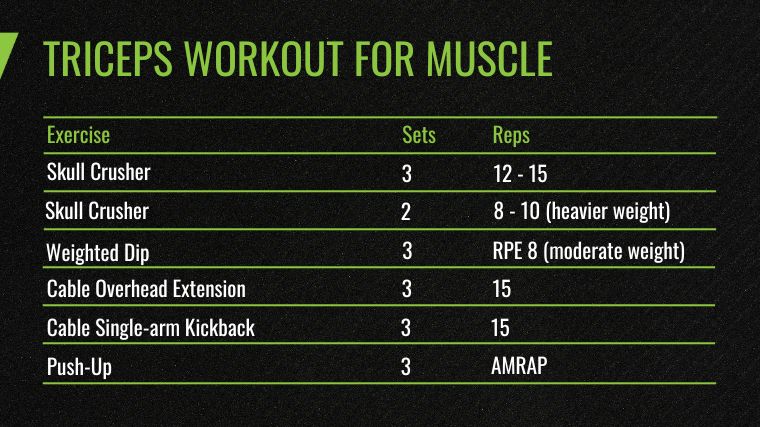
- Skull Crusher: 3 x 12-15, followed by 2 x 8 – 10 at a slightly heavier weight
- Weighted Dip: 3 sets at an RPE 8 with a moderate weight
- Cable Overhead Extension: 3 x 15
- Cable Single-arm Kickback: 3 x 15
- Push-Up: 3 sets of as many repetitions as possible
Triceps Workout for Strength
You’ll hit two strength-focused workouts per week. In total, you’ll accumulate 29 sets for your triceps. You’ll also be lifting in a combination of rep ranges — six to 10 so you’re handling larger weights, and then 12 and up to ensure you build a fatigue resistance.
[Read More: The Most Effective Workout Splits, Created by Our Experts]
Assuming you want stronger triceps for a bigger bench press, the first two movements of each day are a bench press variation. Specificity is king, so if you want a stronger bench press, you need to bench press.
Big Bench Press Accessory Day 1
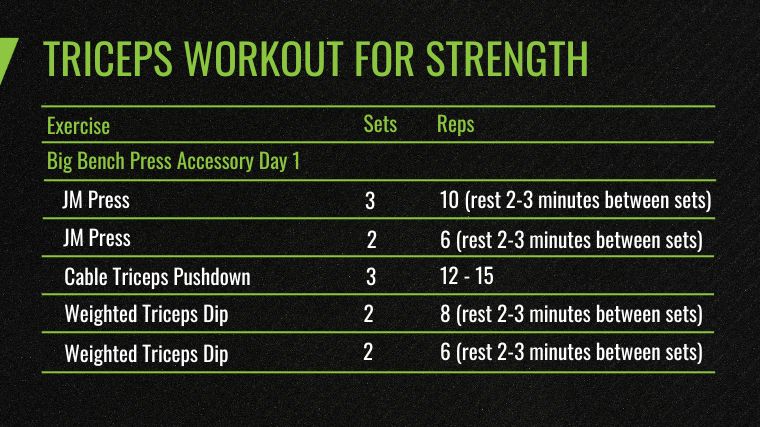
- A1. JM Press: 3 x 10 / 2 x 6, rest 2-3 minutes between sets
- B1. Cable Triceps Pushdown: 3 x 12-15
- C1. Weighted Triceps Dip: 2 x 8, 2 x 6, rest 2-3 minutes between sets
Big Bench Press Accessory Day 2
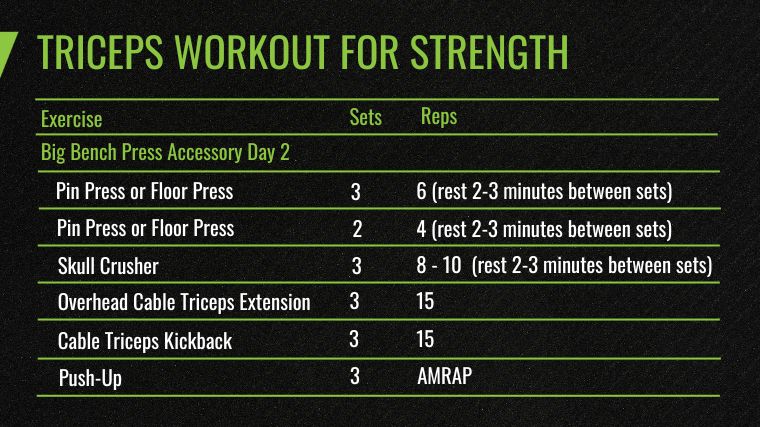
- A1. Pin Press or Floor Press: 3 x 6 / 2 x 4, rest 2-3 minutes between sets
- B1. Skull Crusher: 3 x 8-10, rest 2-3 minutes between sets
- C1. Overhead Cable Triceps Extension: 3 x 15 reps
- C2. Cable Triceps Kickback: 3 x 15 reps
- C3: Push-Up: 3 x AMRAP
Triceps Workout for Bodyweight
You’ve got options when it comes to building your triceps on any free weights. You’ll rely on high rep sets to near-failure since adding more weight to the bar isn’t an option.
Pick one workout and perform it a few times per week — minimum two times, maximum four times. “RIR” stands for reps in reserve and seeing “2 RIR” means you should stop two reps short of mechanical failure. As you progress, aim to add reps to your sets. Ideally, you can do more reps while still feeling as though you’re two reps from failure.
For Beginner Calisthenics Athletes
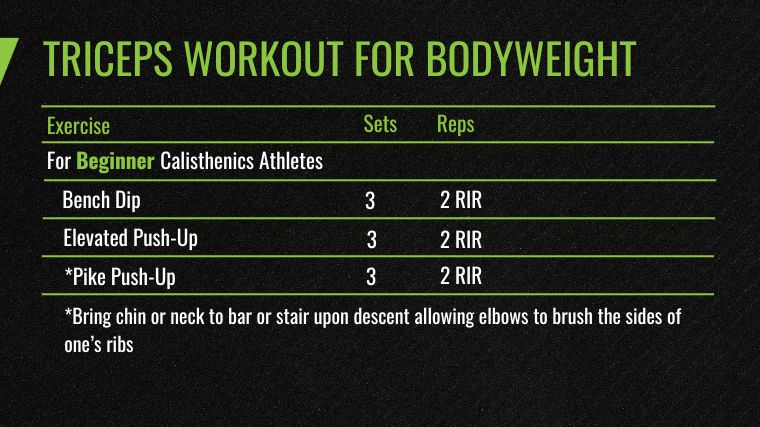
- A1. Bench Dip: 3 sets x 2 RIR
- B1. Elevated Push-Up: 3 sets x 2 RIR
- *C1. Pike Push-Up: 3 sets x 2 RIR
*Bring chin or neck to bar or stair upon descent allowing elbows to brush the sides of one’s ribs
For Advanced Calisthenics Athletes
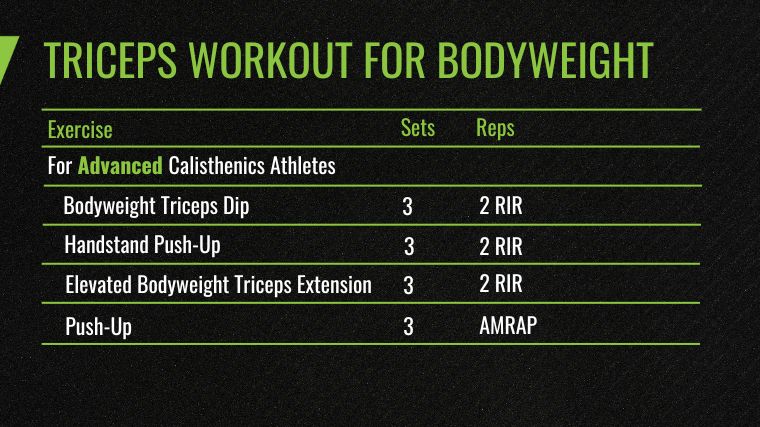
- A1. Bodyweight Triceps Dip: 3 sets x 2 RIR
- B1. Handstand Push-Up: 3 sets x 2 RIR
- C1. Elevated Bodyweight Triceps Extension: 3 sets x 2 RIR
- D1: Push-Up: 3 sets x AMRAP
Triceps Warm-Up
Especially if you’re going to do a heavy triceps workout, make sure you’re not going in cold. Even if you’re going to focus mainly on your chest or shoulders, your triceps will need to be ready for a hefty ride. Here’s a solid triceps dynamic warm-up to integrate into your program before your upper body workouts.
| Exercise | Sets | Reps |
|---|---|---|
| Banded Triceps Pushdown | 1 | 20 – 25 |
| Triceps Kickback | 1 | 12 – 15 per side |
| Close-Grip Push-Up | 1 | 10 – 15 |
How To Train Your Triceps
Depending on your workout split, you’ll want to either include short triceps-specific workouts at the end of days focused on bigger upper body exercises or simply take an extra rest day while you’re in the process of building your arms.
- Exercise Selection: To build strength, prioritize free-weight, compound triceps exercises like bench presses. To isolate your triceps for growth, include cable triceps exercises as well and perform most sets to nearly failure.
- Sets and Reps: We tend to prefer lower reps (5 to 8) for compound exercises like presses or dips, and higher reps in the 12 to 20 range for isolation moves.
Choose Your Volume
Most evidence-based recommendations regarding optimal training volume fall between 10 and 20 “working” sets per muscle, per week. (1) If you’re used to hitting it hard in the gym, this may seem like a light load.
However, the good news is that you can probably get the same, or better, arm gains without committing to multi-hour workouts. Mind also that compound lifts do factor into this benchmark; if you perform plenty of heavy bench or overhead presses twice a week, you probably don’t need 15 sets of triceps extensions on top of it all.
Find the Right Angle
It pays to be flexible in your pursuit of eye-popping, shirt-busting triceps. Yes, you need good mobility in your elbows and shoulders for some arm exercises, but you should really open yourself up to a wide array of exercises and angles during your workouts if you want to maximize your gains.
As a three-headed muscle, certain sections of your triceps will work harder than others on certain exercises based on your posture and leverages at any given moment. (2) For example, the long head of the muscle gets the most love when your arm is extended behind your head.
Go Overhead
Some compelling research has shown that overhead extensions, when your arm is raised up behind your head, can be more effective at both long head emphasis and overall triceps growth — even more than traditional press downs. (3)
Mix in at least one overhead-based triceps exercise every time you train your arms and the results will likely speak for themselves.
Benefits of Training Your Triceps
Bigger, stronger triceps make you, well, bigger and stronger. You aren’t going to win and bodybuilding shows if your guns are only loaded in the front. Your triceps may also be the limiting factor the next time you try to test your 1-rep max on the bench press. There are plenty of good reasons to prioritize your triceps in the gym.
Better Pressing Strength
Your triceps fight half the battle on all pressing movements, whether you’re on the barbell bench press or working with dumbbells. If your elbow extensors are underdeveloped or weak, don’t expect to lock out any of your max-effort reps. Some extra triceps work is a great way to safeguard yourself against missing a max attempt.
Balanced Physique Development
Well-developed arms may not win bodybuilding shows on their own, but if your triceps are lacking on the physique stage, it can bring down your entire physique. Even if you don’t have competitive aspirations, doing nothing but biceps curls and neglecting your tris is no way to build an impressive physique.
Your triceps make up the majority of overall muscle in your upper arm, and that’s before training. That means plenty of untapped hypertrophic potential. If you want to look symmetrical and proportional, carving out those horseshoes is an absolute must.
Triceps Anatomy
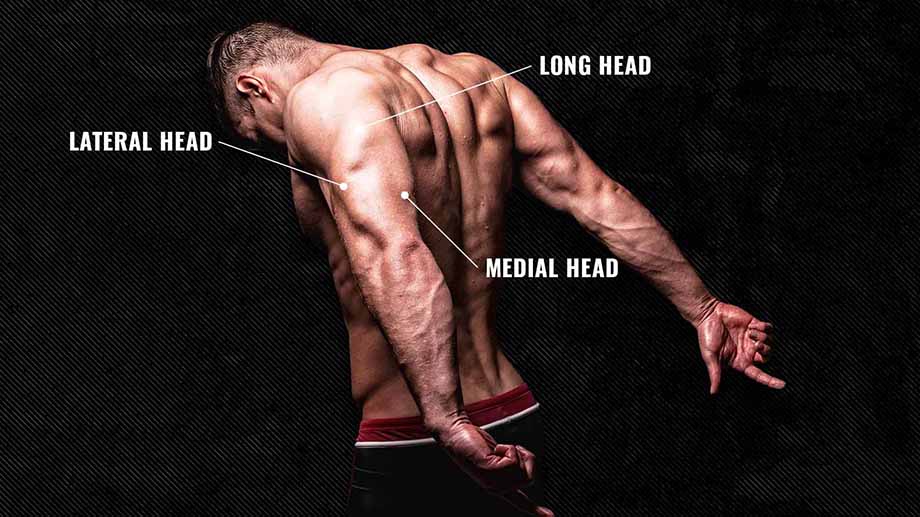
The triceps are made up of three muscles (hence the name, tri-ceps): The lateral head, the long head, and the medial head. All three of these muscles attach to your elbow and are responsible for extending your elbow.
The triceps are involved in the latter half of most pressing exercises. Think about how you bench press. Your pecs work hard at first to get the barbell off of your chest, but once your arms break 90 degrees, your triceps flex to extend your forearms and fully extend your arms. The same is true for an overhead press.
FAQs
How many triceps exercises should you do per workout?
Your triceps get a lot of work, even when you aren’t working them directly. If you perform upper-body exercises like bench presses or push-ups, we recommend including only one or two triceps isolation moves as well.
How do you work all 3 heads of the triceps?
Two parts of your triceps are used when you extend your elbow, no matter where your arm is. So, any triceps exercise will cover your bases. To target the long head, you’ll need to perform at least one overhead triceps movement.
Are dips a good exercise for triceps?
Yes, but there’s a catch — bodyweight dips are easy enough for most folks, but rapidly become quite difficult once you start adding weight. If you enjoy dips you can certainly make them a main triceps movement, but if they’re more trouble than they’re worth, feel free to discard dips for other moves.
References
- Schoenfeld, B. J., Ogborn, D., & Krieger, J. W. (2017). Dose-response relationship between weekly resistance training volume and increases in muscle mass: A systematic review and meta-analysis. Journal of sports sciences, 35(11), 1073–1082.
- Kholinne, E., Zulkarnain, R. F., Sun, Y. C., Lim, S., Chun, J. M., & Jeon, I. H. (2018). The different role of each head of the triceps brachii muscle in elbow extension. Acta orthopaedica et traumatologica turcica, 52(3), 201–205.
- Maeo, S., Wu, Y., Huang, M., Sakurai, H., Kusagawa, Y., Sugiyama, T., Kanehisa, H., & Isaka, T. (2022). Triceps brachii hypertrophy is substantially greater after elbow extension training performed in the overhead versus neutral arm position. European journal of sport science, 1–11. Advance online publication.
Featured Image: Bojan Milinkov/Shutterstock